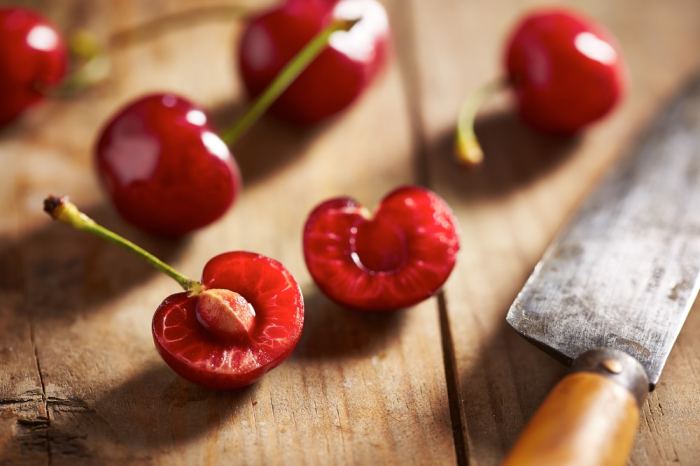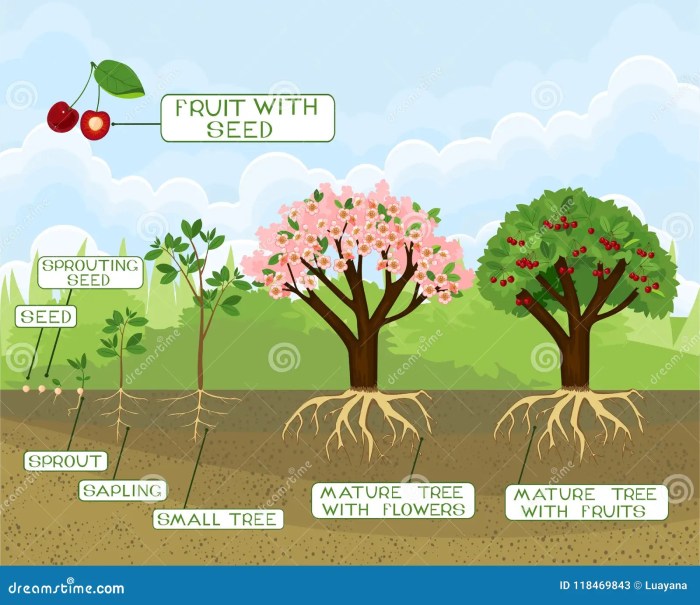How to Plant Cherry Tree Seeds
Seed Acquisition and Preparation
How to plant cherry tree seeds – Successfully growing cherry trees from seed requires careful attention to seed selection, cleaning, and preparation. The viability and germination rate significantly depend on these initial steps. Choosing high-quality seeds from healthy trees and properly preparing them for planting are crucial for success.
Ideal Cherry Tree Seed Characteristics
For optimal germination, select seeds from mature, healthy cherry trees exhibiting vigorous growth and abundant fruit production. The seeds should be plump, firm, and free from visible damage or discoloration. Avoid seeds that are shriveled, cracked, or show signs of insect infestation. Seeds from the sweetest and healthiest cherries generally offer the best chance of successful germination.
Collecting Cherry Tree Seeds
Harvest seeds from fully ripe cherries. The cherries should be soft and easily squeezed, indicating ripeness. Remove the seeds carefully, avoiding damage to their delicate outer layer.
Cleaning and Preparing Cherry Seeds
After collecting the seeds, remove the surrounding pulp thoroughly. This can be done by rinsing the seeds under running water and gently rubbing them to remove the flesh. Thorough cleaning prevents mold and fungal growth during stratification. Once cleaned, spread the seeds on a clean, dry surface, ensuring good air circulation to prevent moisture retention and potential rot. Allow the seeds to dry for several days, or until they reach a moisture content suitable for storage.
Seed Stratification for Improved Germination
Cherry seeds require a period of cold stratification to break dormancy and improve germination rates. This mimics the natural conditions seeds experience over winter. This process involves exposing the seeds to cold, moist conditions for a specified period.
- Mix the seeds with a moist medium: Combine the seeds with a slightly damp medium like vermiculite or peat moss in a ratio of 1:2 (seeds:medium).
- Place in a sealed container: Put the mixture into a sealed plastic bag or airtight container.
- Refrigerate for 60-90 days: Store the container in the refrigerator at a temperature between 33°F and 41°F (0°C and 5°C) for approximately 60-90 days. This cold treatment breaks dormancy.
- Check for moisture: Periodically check the moisture level; if it gets too dry, lightly mist the mixture with water.
- Prepare for sowing: After stratification, remove the seeds from the refrigerator and allow them to reach room temperature before sowing.
Sowing and Germination
The method of sowing – direct sowing outdoors versus starting indoors – significantly influences the success rate and timing of germination. Choosing the right method depends on your climate and resources.
Comparison of Sowing Methods
| Method | Advantages | Disadvantages | Success Rate (Estimate) |
|---|---|---|---|
| Direct Sowing | Simpler, less labor-intensive; establishes trees directly in their permanent location. | Lower germination rate; susceptible to environmental factors; slower growth. | 40-60% |
| Starting Indoors | Higher germination rate; better control over environmental conditions; faster growth; protection from pests and harsh weather. | More labor-intensive; requires transplanting; potential for transplant shock. | 70-80% |
Ideal Soil Composition and pH

Source: garden.eco
Cherry seeds thrive in well-drained, slightly acidic to neutral soil with a pH range of 6.0 to 6.5. A well-balanced soil mix containing compost or other organic matter improves drainage and provides essential nutrients. Avoid heavy clay soils, which can retain too much water and lead to root rot.
Planting cherry tree seeds requires careful stratification to mimic winter conditions. The process is quite different from planting other seeds; for instance, understanding the nuances of how to plant catnip seeds offers a helpful contrast. Successfully germinating cherry seeds demands patience and attention to detail, unlike the often faster growth of catnip. Proper soil preparation and consistent moisture are crucial for both, however.
Planting Schedule
The optimal time for sowing cherry seeds depends on your climate. In regions with mild winters, fall sowing is often preferred, allowing seeds to undergo natural stratification over winter. In colder climates, spring sowing after the last frost is recommended. Starting seeds indoors allows for year-round planting, extending the growing season.
Sowing Seeds: Depth and Spacing
Sow seeds at a depth of about twice their diameter. For direct sowing, space the seeds approximately 6-12 inches apart. When starting indoors, sow seeds individually in small seed trays or pots, ensuring adequate spacing to prevent overcrowding.
Maintaining Optimal Moisture
Maintain consistently moist but not waterlogged soil throughout the germination process. Regular watering, but avoiding overwatering, is crucial. Use a watering can with a fine rose to avoid disturbing the delicate seeds. Keep an eye on the soil moisture level and water when the top inch feels dry.
Seedling Care and Growth
Providing the right conditions for young cherry seedlings is critical for their healthy development and survival. This includes appropriate sunlight, watering, pest and disease management, and fertilization.
Sunlight and Watering
Cherry seedlings need at least six hours of direct sunlight daily. Water regularly, keeping the soil consistently moist but not soggy. Adjust watering frequency based on weather conditions and soil type. Overwatering can lead to root rot, while underwatering can stunt growth.
Pest and Disease Protection
Cherry seedlings are susceptible to various pests and diseases. Common threats include aphids, spider mites, leaf spot, and powdery mildew. Regularly inspect seedlings for signs of infestation or disease. Preventative measures include proper spacing to improve air circulation, using disease-resistant varieties, and applying appropriate organic or chemical controls as needed.
Transplanting Seedlings
Once seedlings develop a few true leaves and reach a manageable size (around 4-6 inches tall), carefully transplant them into larger containers or directly into the ground. Handle seedlings gently to avoid damaging their roots. Gradually acclimate outdoor-grown seedlings to direct sunlight to prevent shock.
Fertilization Plan
Young cherry trees benefit from regular fertilization. Use a balanced, slow-release fertilizer specifically formulated for fruit trees. Follow the manufacturer’s instructions for application rates and frequency. Avoid over-fertilizing, which can damage the roots.
Common Seedling Problems and Solutions
Several issues can affect cherry seedlings. Damping-off, a fungal disease, can kill seedlings. Nutrient deficiencies manifest as yellowing leaves or stunted growth. Ensure good drainage, avoid overwatering, and use a balanced fertilizer to address these problems.
- Damping-off: Improve soil drainage, avoid overwatering, and consider using a fungicide.
- Nutrient deficiencies: Apply a balanced fertilizer containing essential nutrients.
Transplanting and Aftercare: How To Plant Cherry Tree Seeds
Transplanting cherry seedlings to their permanent location requires careful planning and execution. Proper spacing, soil preparation, and support are crucial for successful establishment and growth.
Step-by-Step Transplanting Guide
- Prepare the planting hole: Dig a hole twice as wide and as deep as the root ball.
- Loosen the soil: Break up compacted soil at the bottom of the hole to encourage root growth.
- Remove the seedling: Gently remove the seedling from its container, being careful not to damage the roots.
- Place in the hole: Position the seedling in the hole, ensuring the top of the root ball is level with the ground.
- Backfill the hole: Gently fill the hole with soil, firming it around the roots.
- Water thoroughly: Water deeply to settle the soil and help the roots establish.
Optimal Spacing and Soil Preparation, How to plant cherry tree seeds

Source: dreamstime.com
Space cherry trees according to the mature size of the variety. For standard-sized trees, allow 20-30 feet between trees. Amend the soil with organic matter such as compost to improve drainage and fertility. Ensure the soil is well-drained to prevent root rot.
Supporting Young Trees
Young cherry trees are susceptible to wind damage. Use stakes or tree guards to provide support, especially during windy periods. Tie the tree gently to the stake, avoiding constricting the trunk.
Long-Term Care
Long-term care includes regular pruning to maintain tree shape and health, consistent watering, and ongoing pest and disease management. Monitor the trees for signs of problems and take appropriate action promptly.
Mulching Technique
Apply a 2-3 inch layer of organic mulch (e.g., wood chips, shredded bark) around the base of the tree, keeping it a few inches away from the trunk. This helps conserve moisture, suppress weeds, and regulate soil temperature. The mulch should create a neat, even layer around the tree, resembling a donut shape, leaving the trunk exposed.
Factors Affecting Growth
Several environmental and biological factors significantly influence the growth and productivity of cherry trees. Understanding these factors helps optimize growing conditions and manage potential problems.
Key Environmental Factors
Sunlight, temperature, and water are essential for cherry tree growth. Adequate sunlight (at least 6 hours daily) is crucial for photosynthesis. Temperature extremes can stress trees, affecting growth and fruit production. Consistent moisture is needed, but avoid overwatering or waterlogged conditions.
Growth Habits of Cherry Tree Varieties
Different cherry tree varieties exhibit varying growth habits. Some are dwarf varieties, remaining smaller and more compact, while others are standard-sized trees, reaching considerable heights. Consider the mature size of the variety when selecting a location for planting.
Impact of Soil Type and Drainage
Well-drained soil is crucial for cherry tree health. Heavy clay soils can lead to root rot, while sandy soils may not retain enough moisture. Amend heavy clay soils with organic matter to improve drainage. Sandy soils may benefit from the addition of compost or other organic materials to improve water retention.
Role of Pollinators
Most cherry trees require cross-pollination for fruit production. Bees and other pollinators are essential for transferring pollen between different cherry tree varieties. Plant at least two different, compatible varieties to ensure adequate pollination.
Common Diseases and Pests
Cherry trees are susceptible to various diseases and pests. Common problems include leaf spot, powdery mildew, aphids, and borers. Regular monitoring, preventative measures (such as proper sanitation and cultural practices), and timely treatment with appropriate methods (organic or chemical controls) are essential for maintaining tree health.
FAQs
Can I use seeds from any cherry?
While you can, success rates vary widely. Seeds from sweet cherries generally germinate less readily than those from sour cherries. Choose ripe, healthy fruit from a known variety for best results.
How long does it take for cherry seeds to germinate?
Germination can take several weeks to several months, depending on the variety, stratification techniques, and environmental conditions. Patience is key!
What if my seedlings get leggy?
Leggy seedlings indicate insufficient light. Increase light exposure, either by moving them closer to a light source or supplementing with grow lights.
When should I prune my young cherry tree?
Pruning is best done in late winter or early spring before new growth begins. Focus on removing dead, damaged, or crossing branches to improve air circulation and sunlight penetration.





















